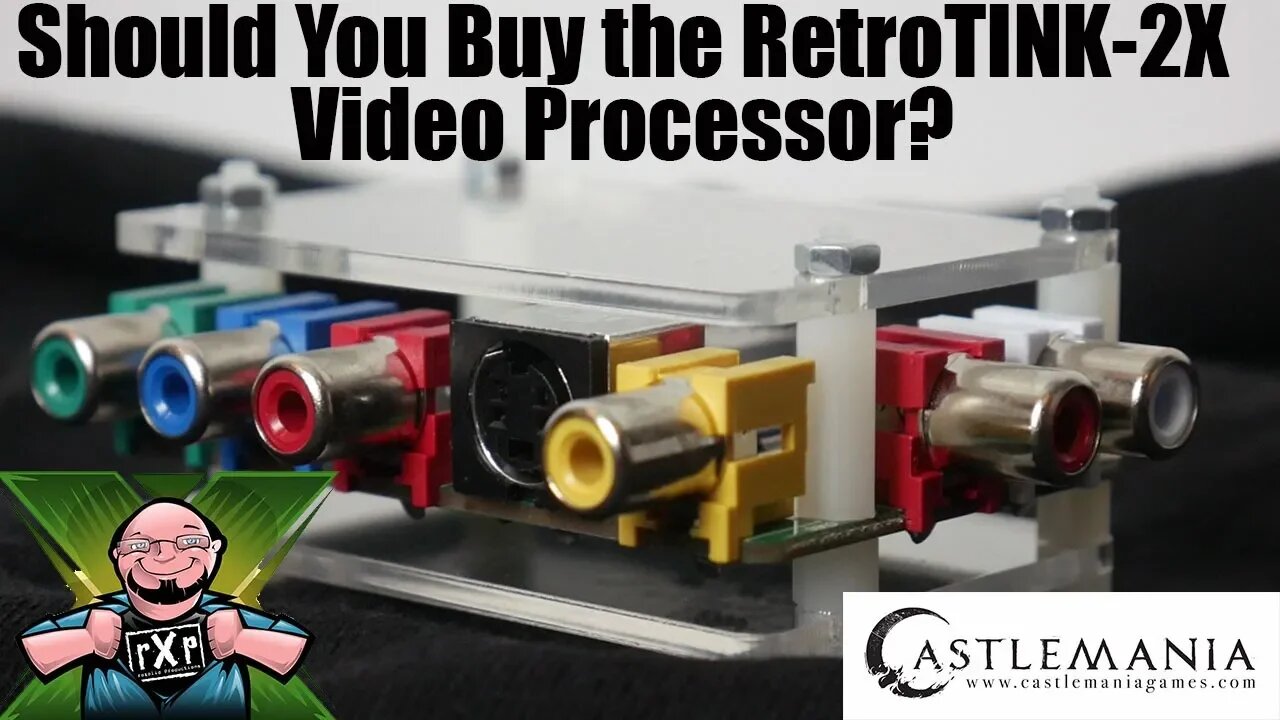Premium Only Content

Should you buy the RetroTink 2x Video Line Doubler & Video Processor for Retro Video Game Systems?
In this video, we take a look at and test the RetroTink 2X video processor and line doubler.
Just about everybody will agree the best way to play retro games on original hardware. You don't have to worry about compatibility issues, sound or colors being off, and the controllers just work. One of the hard things about this is how to hook up your old systems to your modern TVs via HDMI. There are some expensive options out there such as the Framemeister and the OSSC but a company called RetroTink has released a line doubler for the masses.
The RetroTink 2x is simple in it's design. It can accept component, composite, or S-Video inputs and output them via Mini HDMI cable to standard HDMI. if you don't have a Mini HDMI cable, don't worry, you can get them from Castle Mania games.com, exactly where you can get the RetroTink 2x from as well.
One of the two major reasons why I wanted this was to be able to play my Sharp Famicom Twin via HDMI and capture or stream the footage. I don't know if my expectations were too high but the Famicom did not look as sharp as I'd hoped.I was really hoping that things would look a lot sharper than they wound up, but it is definitely sharper than using one of those cheap AV2HDMI boxes, or simply going straight into the television itself.
Next up was my Super NES Junior, which I have RGB modded with one of Voultar’s RGB boards. Going into my OSSC I could have issues at times with the system either not looking right, frame loss, audio distortion, just the Super NES does not play well with the OSSC. Well, I will tell you that I was blown away at how gorgeous the Super NES looked using HD Retrovision component video cables. Street Fighter II looked amazing, so did Earthworm Jim. I did notice the blacks had a little bit of a red hue to them, which I thought was a little odd.
Next up with my N64, and I will say playing Star Wars Rogue Squadron on it the system looked amazing. It's probably the best I have ever seen this system luck, also using HD Retrovision cables and a Voultar RGB Mod Board, and I didn't have any of the compatibility issues that I can sometimes have with the OSSC.
Why it RoX:
- Inexpensive
- Great compatibility with a variety of systems
- Super easy to use
- Component, composite and S-Video inputs
- Passthrough option
- Compact
- Can output to the OSSC via optional cable
What could be improved?
- Composite video, while better, is still not as sharp as HDMI (Nor will it ever be)
- Website could use a better Q&A section
- Some may not like the “builder” look of the unit
- Mini HDMI out instead of standard HDMI
- Still working through supply issues with high demand
Should you buy one?
if you're looking to get the best picture quality out of original hardware and not spend a fortune the RetroTink 2x is an amazing piece of hardware. It flat-out just works. The main thing that you need to do is make sure that you have that mini HDMI cable but above and beyond that you're ready to rock and roll. While the composite video still looked a little rough, it was leaps and bounds better than straight composite into my television. Where I was most impressed with the RetroTink 2x was with the Super NES Jr., specifically playing Super Street Fighter II. It looked so good, I was blown away. I don’t know that the capture and compression of YouTube makes it pop like it did in my gaming room, but this alone made the RetroTink 2x worth the investment. I can see this being widely used in game rooms all over, it is a no-brainer purchase to me.
The footage used in this review are used under the Fair Use laws, referenced below:
https://www.law.cornell.edu/uscode/text/17/107
Notwithstanding the provisions of sections 106 and 106A, the fair use of a copyrighted work, including such use by reproduction in copies or phonorecords or by any other means specified by that section, for purposes such as criticism, comment, news reporting, teaching (including multiple copies for classroom use), scholarship, or research, is not an infringement of copyright. In determining whether the use made of a work in any particular case is a fair use the factors to be considered shall include—
(1) the purpose and character of the use, including whether such use is of a commercial nature or is for nonprofit educational purposes;
(2) the nature of the copyrighted work;
(3) the amount and substantiality of the portion used in relation to the copyrighted work as a whole; and
(4) the effect of the use upon the potential market for or value of the copyrighted work.
The fact that a work is unpublished shall not itself bar a finding of fair use if such finding is made upon consideration of all the above factors.
(Pub. L. 94–553, title I, § 101, Oct. 19, 1976, 90 Stat. 2546; Pub. L. 101–650, title VI, § 607, Dec. 1, 1990, 104 Stat. 5132; Pub. L. 102–492, Oct. 24, 1992, 106 Stat. 3145.)
-
 53:35
53:35
RoXolidProductions
8 months ago $0.01 earnedThe Ultimate Retro Gaming Upgrade | RetroTink 4K Review
2742 -
 8:50:58
8:50:58
Right Side Broadcasting Network
1 day ago🎅 LIVE: Tracking Santa on Christmas Eve 2024 NORAD Santa Tracker 🎅
329K46 -
 2:48
2:48
Steven Crowder
1 day agoCROWDER CLASSICS: What’s This? | Nightmare Before Kwanzaa (Nightmare Before Christmas Parody)
309K12 -
 33:49
33:49
Quite Frankly
1 day agoThe Christmas Eve Midnight Telethon
113K22 -
 2:12:46
2:12:46
Price of Reason
1 day agoAmber Heard BACKS Blake Lively Lawsuit Against Justin Baldoni! Is Disney CEO Bob Iger in TROUBLE?
65.1K24 -
 1:01:17
1:01:17
The StoneZONE with Roger Stone
19 hours agoChristmas Edition: Why the Panama Canal is Part of the America First Agenda | The StoneZONE
135K49 -
 18:12:15
18:12:15
LFA TV
1 day agoLFA TV CHRISTMAS EVE REPLAY
148K19 -
 13:32
13:32
Scammer Payback
20 hours agoChanging the Scammer's Desktop Background to his Location
16.8K4 -
 4:21
4:21
BIG NEM
23 hours agoNikola Tesla's Secret to Cultivating Creativity & Genius
12.5K1 -
 15:03
15:03
The Anthony Rogers Show
1 day agoAnthony Rogers - Live at Cusumano's Pizza (Upstairs)
9.98K1